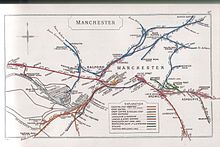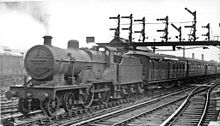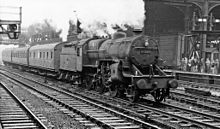- Manchester Victoria station
-
Manchester Victoria 
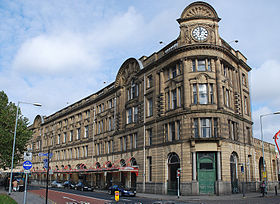
Location Place Manchester city centre Local authority Manchester Coordinates 53°29′14″N 2°14′33″W / 53.4872°N 2.2424°WCoordinates: 53°29′14″N 2°14′33″W / 53.4872°N 2.2424°W Operations Station code MCV Managed by Northern Rail Number of platforms 6 Live arrivals/departures and station information
from National Rail EnquiriesAnnual rail passenger usage 2006/07 * 5.060 million 2007/08 *  4.006 million
4.006 million2008/09 *  5.790 million
5.790 million2009/10 *  5.870 million
5.870 millionPassenger Transport Executive PTE Greater Manchester Zone City (D) History 1844 Opened 1902 Extended 1996 Repaired National Rail - UK railway stations A B C D E F G H I J K L M N O P Q R S T U V W X Y Z * Annual passenger usage based on sales of tickets in stated financial year(s) which end or originate at Manchester Victoria from Office of Rail Regulation statistics. Please note: methodology may vary year on year. Manchester Victoria station in Manchester, England is the city's second largest mainline railway station. It is also a Metrolink station, one of eight within the City Zone. It is situated to the north of the city centre on Hunts Bank, close to Manchester Cathedral.
The station serves destinations north and east of Manchester, with some trains to Liverpool (mostly on the original Manchester to Liverpool line). The line from Bury was converted to light-rail operation in the early 1990s when the Metrolink tram system was created, and the trams switch to on-street running once they emerge from Victoria Station. Current plans for Phase 3 of Metrolink involve the conversion of the rail routes from Victoria to Rochdale via Oldham to light rail. Most trains calling at the station are operated by Northern Rail, except during engineering works, when some trains are diverted from Manchester Piccadilly.
Contents
History
In 1838 Samuel Brooks, vice-chairman of the Manchester and Leeds Railway (M&LR) bought land at Hunt's Bank close to the cathedral and presented it to the company for a station to replace the inconveniently located Manchester Oldham Road railway station opened by the company on 3 July 1839. The station was initially a long low single-storey building designed by George Stephenson and completed by John Brogden[1] on 1 January 1844. It was named Victoria by permission of Her Majesty. The long single platform handled M&LR trains to Leeds and elsewhere at its eastern end. The Liverpool and Manchester Railway extended its line from Ordsall, near the original Manchester Liverpool Road railway station, and its trains operated from Victoria's western end from 4 May 1844.[2]
Railway Clearing House map of central Manchester railways in 1910
 Platforms 11 (left) and 12 (right), looking west towards Manchester Exchange in 1948
Platforms 11 (left) and 12 (right), looking west towards Manchester Exchange in 1948
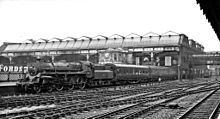 Platform 12, as seen looking north-east from Platform 3 of Manchester Exchange in 1960
Platform 12, as seen looking north-east from Platform 3 of Manchester Exchange in 1960
By the mid-1840s six railway companies operated from the station connecting Manchester to London, Glasgow, Liverpool, Leeds and Sheffield. Victoria Station came to dominate the Long Millgate area and was one of the biggest passenger stations in Britain.
Victoria was enlarged by William Dawes, who is responsible for most of the remaining facade, in 1909. The enlarged building was erected on land originally consecrated as a burial ground on 1 January 1815 by the Bishop of Chester; this land had been acquired by the Manchester and Leeds Railway in 1844.[3] It eventually boasted 17 platforms. Wealthy commuters travelled here from Blackpool and Southport rather faster than is possible today (e.g. 45 minutes from Southport in 1910, 67 today; and 65 minutes from Blackpool in 1910, 77 today) in specially-constructed club cars hauled by express steam locomotives. These non-stop services were abandoned in the early 1960s.
The Edwardian building has a 160 yards (146 m) facade, which carries an iron and glass canopy bearing the names of the original destinations served, and a tile mural depicting the routes of the Lancashire and Yorkshire Railway, which operated most of the trains from the station between 1847 and 1923, when it became one of the main constituents of the London, Midland and Scottish Railway. The canopies served as a covered waiting area for taxi cabs until they were damaged in the Provisional IRA 1996 bombing. They have been restored. The cast-iron train sheds behind the façade are 700 yards (640 m) long. Initially the station was approached by a wooden footbridge over the River Irk, which has subsequently disappeared beneath culverting alongside the cathedral.
From 1884, Victoria Station was adjacent to Manchester Exchange Station, operated by the rival London and North Western Railway, and, from 1929, a single passenger platform linked the stations; this was the longest passenger platform in Europe at 2,194 feet (669 m). Exchange Station was closed in 1969 and its services were transferred to Victoria. Its site opposite the cathedral is now a car park.
In the early 1970s, as part of the Picc-Vic tunnel project, there were proposals to build an underground station, Victoria Low Level.[4] The project was cancelled and subsequent rail improvements concentrated on surface projects and the introduction of light rail.
Victoria is the main station for the adjacent Manchester Evening News Arena, which was joined to the station between 1992 and 1996 by means of a raft above the through rail platforms. The principal access to the MEN Arena is via stairs on Hunts Bank although there is an entrance from the main station concourse.
Facilities
The station has a barber's shop, newsagents, coffee bars and buffet. Network Rail aims to lease offices on the first and second floors to businesses. In 2009 the station was identified as one of the ten worst category B interchange stations for its fabric and environment. Victoria was set to receive a £5m share of the £50m 'Better Stations' Network Rail funding for improvements; this was cancelled in the June 2010 budget cuts, but a replacement funding package has since been arranged.[5]
Station refurbishment
In November 2009, it was announced that Manchester Victoria was officially the worst station in Britain. As a result, the transport secretary, Lord Adonis, announced that, along with nine others, it would receive an urgent injection of £50 million and an emergency rebuilding programme.[6]
It is intended to build new west-facing platforms for terminating services to and from Yorkshire and the Humber. New shops and cafés will be included. After agreeing a £30 million funding package with Manchester City Council and the North West Development Agency, Network Rail will replace the roof, refurbish the station toilets, and install new passenger help points and wind-break shelters on Platforms 3-6.[7] However, as part of cuts announced by the coalition government, a £5 million grant from the Department for Transport was withdrawn, making the project uncertain.[8]
On 16 February 2010 it was reported that Network Rail intended to refurbish Manchester Victoria as part of the Northern Hub improvement proposals. The station will become an interchange for local and regional services throughout the North West of England.[citation needed] In August 2010, Network Rail announced that the refurbishment of Victoria Station would go ahead, despite the government withdrawing £5 million funding from the scheme.[9]
Services
Manchester Victoria is served by a single train operating company, Northern Rail. It is occasionally used by First Transpennine Express and CrossCountry services during engineering works.
Northern Rail operates Class 142 pacers and 150 or 156 Sprinter DMUs on most train services around Manchester, while the Leeds Calder Valley services are usually operated by Class 155 or 158 Sprinter DMUs. The Leeds via Dewsbury services mainly use 3-car Class 144 Monday - Friday, although at weekends this service sees other classes on the route such as a pair of Class 153 DMUs or Class 150 or 155. Because of a shortage of rolling stock, Class 180s are often used on Blackpool services, an example of high-speed trains capable of 125 mph being used on slow stopping services.
Manchester Victoria is used by Transpennine Express as a diversionary route and alternative station when the route through Manchester Piccadilly is unavailable as a result of engineering works. Night services between Manchester Airport and York run via Manchester Victoria, although they do not stop. They then run via Ashton-under-Lyne to rejoin the usual route at Stalybridge, or continue through Rochdale and Hebden Bridge before reaching Huddersfield.
Service summary
- 2 trains per hour (tph) to Wigan Wallgate (via Bolton) calling:
-
- Salford Central, Salford Crescent, Kearsley, Farnworth, Moses Gate, Bolton and Wigan Wallgate
-
- Salford Central, Salford Crescent, Bolton, Westhoughton, Hindley and Wigan Wallgate
- 1tph to Kirkby calling:
- 1tph to Southport calling:
-
- Salford Central, Salford Crescent, Swinton, Walkden, Atherton, Daisy Hill, Hindley, Wigan Wallgate, Gathurst, Appley Bridge, Parbold, Hoscar, Burscough Bridge, New Lane, Bescar Lane, Meols Cop and Southport
Note that the Monday - Saturday peak 17:06 is a faster Wigan Wallgate service, which calls only at:
-
- Salford Central, Salford Crescent, Atherton, Daisy Hill, Wigan Wallgate, Gathurst, Appley Bridge, Parbold, Burscough Bridge, Meols Cop and Southport.
- 1tph to Blackpool North calling at:
-
- Salford Central, Salford Crescent, Bolton, Lostock, Horwich Parkway, Blackrod, Adlington, Chorley, Leyland, Preston, Kirkham and Wesham, Poulton-le-Flylde, Layton and Blackpool North
- 1tph to Clitheroe calling at:
-
- Salford Central, Salford Crescent, Bolton, Hall-i-th-Wood, Bromley Cross, Darwen, Blackburn, Ramsgreave & Wilpshire, Langho, Whalley and Clitheroe
- 1tph to Rochdale, calling at:
-
- Moston, Mills Hill, Castleton and Rochdale
- 1tph to Liverpool Lime Street calling at:
-
- Eccles, Patricroft, Newton-le-Willows, Earlestown, St. Helens Junction, Lea Green, Rainhill, Whiston, Huyton, Roby, Broad Green, Wavertree Tech Park, Edge Hill and Liverpool Lime Street
- 1tph to Stalybridge calling at:
-
- Ashton-under-Lyne and Stalybridge
- 1tph to Huddersfield calling at:
-
- Ashton-under-Lyne, Stalybridge, Mossley, Greenfield, Marsden, Slaithwaite and Huddersfield
- 2tph to Leeds calling at:
-
- Rochdale, Smithy Bridge (1tph), Littleborough (1tph), Walsden (1tph), Todmorden, Hebden Bridge, Mytholmroyd (1tph), Sowerby Bridge (1tph), Halifax, Bradford Interchange, New Pudsey, Bramley and Leeds
-
- Moston, Mills Hill , Castleton, Rochdale, Smithy Bridge, Littleborough, Walsden (1800 service only), Todmorden, Hebden Bridge, Mytholmroyd, Sowerby Bridge, Brighouse, Mirfield , Ravensthorpe (Peak Hours only) , Dewsbury , Batley , Morley , Cottingley (peak hours only) and Leeds
Electrification
In July 2009, it was announced that the line between Manchester and Liverpool (via Earlestown) will be electrified at 25 kV ac (overhead line). Class 319 EMUs will be used on services from Victoria and Piccadilly to Liverpool Lime Street. The project is expected to be completed within four years.
Victoria Metrolink station
Victoria
Manchester Metrolink 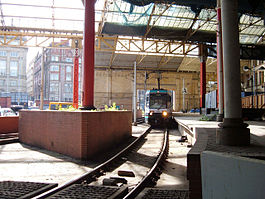
Victoria station, showing a tram entering. The platforms are off-shot. Location Place Manchester city centre Local authority Manchester Fare zone information Metrolink Zone D (City) Conversion to Metrolink operation 4 June 1992 to Bury 

to Rochdale 


Victoria 






Second City Crossing 


Shudehill 


High Street Exchange Square 


Market Street 


Mosley Street 


Piccadilly Gardens 


Piccadilly 
St Peter's Square 


to Ashton-under-Lyne D'gate-Castlefield 


(  Deansgate)
Deansgate)





Cornbrook to MediaCityUK and Eccles 


Trafford Bar 





to East Didsbury and to Altrincham 

Manchester Airport  UK Trams portal
UK Trams portalManchester Victoria is served by Manchester's Metrolink light rail system, at the northern edge of the City Centre zone, forming part of the Bury Line. Metrolink services run through Victoria to Bury, Altrincham and Piccadilly. Trams enter Victoria station from Shudehill Interchange by crossing Corporation Street and Long Millgate and passing through a specially constructed arch in the station wall. From there they curve right and stop at the Metrolink platforms.
The Metrolink station is at the southern end of Victoria station, near the exits, and occupies the site of the former Bury electric train platforms. The Metrolink station was originally built with three platforms, denoted A, B and C; Platform A, close to the point where the trams enter the station, was used for Bury-bound trams, but is now closed to public use due to leaks in the station roof. Platforms B and C, located on a single island platform further along the tracks, are now used, and passengers must cross the tram lines to reach these platforms.
The Metrolink system was opened in 1992, the result of a long-running project to link the two main rail stations in Manchester, Piccadilly and Victoria, with a rail line running across the city.[10] Previous proposals involving an underground railway were abandoned due to costs, but Greater Manchester Council instead secured funding for a light rail solution. The original system was based on the conversion of selected British Rail lines to light rail operation, linked by on-street tram tracks. The Bury line to Victoria opened as a Metrolink line in 1992, replacing former heavy rail services with Metrolink trams.
Future
As part of the Phase 3 of the Metrolink expansion project, it is planned to extend the tram network to Rochdale by converting most of the Oldham Loop Line to light rail operation. The conversion of the line will involve electrification of the route and replacing diesel Pacer and Sprinter train services with the new generation of Flexity Swift trams. The Rochdale line expected to come into service around 2011/2012.[11] Further expansion of the line will see the addition of a Metrolink branch via the old branch line via Oldham Central, the extension of the northern end of the line via a tram line into Rochdale Town Centre and a second city crossing via Exchange Square to St Peter's Square which would require additional platforms to be built to more easily accommodate terminating services.
Gallery
-
An original Manchester Metrolink tram and a Northern Rail Class 158 side by side in the bay platforms
References
- Notes
- ^ Marshall, J.D. (1970). The Lancashire and Yorkshire Railway, volume 1. David and Charles. p. 56. ISBN 0715343521.
- ^ Ferneyhough 1980, p. 105
- ^ Axon 1886, p. 147
- ^ SELNEC PTE (October 1971). SELNEC Picc-Vic Line. SELNEC PTE. publicity brochure
- ^ "£50m revamp for 'worst stations'". BBC News Online (London). 17 November 2009. http://news.bbc.co.uk/1/hi/uk/8363621.stm. Retrieved 2009-11-17.
- ^ Pank, Philip (17 November 2009). "Lord Adonis orders all change for Britain's slum railway stations". The Times (London). http://business.timesonline.co.uk/tol/business/industry_sectors/transport/article6919167.ece. Retrieved 2009-11-17.
- ^ RAIL issue 641
- ^ "Manchester Victoria station's £30m revamp now uncertain". BBC News Online. 25 May 2010. http://news.bbc.co.uk/1/hi/england/manchester/10154987.stm.
- ^ "Victoria revamp to get go-ahead despite cash blow". Manchester Evening News. 4 August 2010. http://menmedia.co.uk/manchestereveningnews/news/transport/s/1312978_victoria_revamp_to_get_goahead_despite_cash_blow.
- ^ Greater Manchester Passenger Transport Executive (1984). Light Rapid Transit in Greater Manchester. GMPTE. - publicity brochure
- ^ Linton, Deborah (13 May 2009). "£1.4bn transport deal unveiled". Manchester Evening News. http://www.manchestereveningnews.co.uk/news/s/1115242_14bn_transport_deal_unveiled. Retrieved 2009-05-17.
- Bibliography
- Axon, William E. (1886). The annals of Manchester: a chronological record from the earliest times to the end of 1885. Manchester and London: J. Heywood, Deansgate and Ridgefield. http://www.archive.org/details/annalsofmanchest00axon.
- Bairstow, Martin (1987). The Manchester & Leeds Railway : the Calder Valley Line. M. Bairstow. ISBN 0-9510302-6-4.
- Ferneyhough, Frank (1980). Liverpool & Manchester Railway 1830-1980. Book Club Associates. ISBN none.
- Wray, Tom (2006). Manchester Victoria Station.
External links
- Tram times and station information for Manchester Victoria station from Manchester Metrolink
Preceding station Manchester Metrolink
Following station towards AltrinchamAltrincham - Bury Line Weekday 10am-4pm onlytowards BuryAbraham MossAll other timestowards Burytowards PiccadillyBury - Piccadilly Line Weekday 10am-4pm onlytowards BuryAbraham MossAll other timestowards Burytowards St Werburgh's RoadSt Werburgh's Road - Victoria Line Terminus Under construction towards East DidsburySouth Manchester Line Terminus Terminus Oldham and Rochdale Line towards Rochdale Town CentreProposed Exchange Squaretowards AltrinchamAltrincham - Bury Line Second City CrossingQueens Roadtowards Burytowards PiccadillyBury - Piccadilly Line  National Rail
National RailTerminus Northern Rail Northern Rail Northern Rail Manchester-Preston LineTerminus Northern Rail Northern Rail Manchester-Southport LineNorthern Rail Monday-Saturday onlyNorthern Rail Manchester-Liverpool LineHistorical Railways Terminus L&YR L&YR London and North Western Railway Manchester-Liverpool LineTerminus Manchester Lines - City Centre and North, (Past, Present and Future) LegendTo Bury 






To Rochdale Moston 






To Oldham Bowker Vale 





Newton Heath 






Newton Heath and Moston 






Crumpsall 






Central Park 






To Tameside Abraham Moss;Monsall 






Clayton Bridge Woodlands Road 






Park Queens Road 






To Tameside Miles Platting 






Edge Lane 






Clayton Oldham Road 






Sportcity-Velodrome Manchester Victoria 






Holt Town/Sportcity-Stadium Exchange 






To Salford 






New Islington 






Ardwick Exchange Square/Shudehill 






Ashburys High Street; Manchester Piccadilly 






Mayfield;To South Manchester Market Street; Piccadilly Gardens 













To Belle Vue;Gorton Moseley Street;Oxford Road 













To Hyde Road St Peter's Square 






To Tameside Manchester Central/Deansgate-Castlefield 






Deansgate Liverpool Road 













To Salford;Cornbrook 






Cornbrook 




Pomona 






To Eccles 






Trafford Bar To Trafford 












Firswood To Trafford;To Altrincham 






To Chorlton Major railway stations in Britain Managed by Network Rail: Managed by train operator: Brighton • Bristol Parkway • Bristol Temple Meads • Cardiff Central • Cardiff Queen Street • Crewe • Doncaster • Glasgow Queen Street • Manchester Victoria • Newcastle • Nottingham • Reading • Sheffield • Southampton • YorkRailway stations of London: Central area | Greater London Managed by Network Rail: Managed by train operator: Blackfriars • Clapham Junction • City Thameslink • Marylebone • Moorgate • Stratford • Waterloo EastMetrolink
Stations City zoneDeansgate-Castlefield · Market Street · Mosley Street · Piccadilly · Piccadilly Gardens · Shudehill · St Peter's Square · Victoria
Altrincham LineAltrincham · Brooklands · Cornbrook · Dane Road · Navigation Road · Old Trafford · Sale · Stretford · Timperley · Trafford Bar
Bury LineAbraham Moss · Besses o'th' Barn · Bowker Vale · Bury · Crumpsall · Heaton Park · Prestwich · Radcliffe · Whitefield · Woodlands Road
Eccles LineAnchorage · Broadway · Eccles · Exchange Quay · Harbour City · Ladywell · Langworthy · MediaCityUK · Pomona · Salford Quays · Weaste
South Manchester LineChorlton · Firswood · St Werburgh's Road

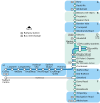
Operations OperatorsStagecoach Group · Transport for Greater ManchesterVehiclesFlexity Swift M5000 · T-68History Former operatorsTransferred linesClosed stationsAbandoned plansUnder Construction Bury LineQueens Road
East Manchester LineAshton Moss · Ashton Under Lyne · Ashton West · Audenshaw · Cemetery Road · Clayton Hall · Droylsden · Eastlands City Stadium · Edge Lane · Holt Town · New Islington · Velopark
Oldham & Rochdale LineCentral Park · Derker · Failsworth · Freehold · Hollinwood · Kingsway · Monsall · Milnrow · Newbold · Newton Heath and Moston · Newhey · Oldham Central · Oldham King Street · Oldham Mumps · Rochdale railway station · Rochdale Town Centre · Shaw & Crompton · South Chadderton · Westwood
South Manchester LinesBaguley · Barlow Moor Rd. · Benchill · Burton Road · Crossacres · Didsbury · East Didsbury · Hardy Farm · Haveley · Hough End · Manchester Airport · Martinscroft · Moor Road · Northern Moor · Peel Hall · Robinswood Road · Roundthorn · Sale Water Park · Shadowmoss · West Didsbury · Withington · Woodhouse Park · Wythenshawe Town Centre · Wythenshawe Park
Proposed Bury LineBuckley Wells
Trafford Centre LineImperial War Museum · Lostock Parkway · Manchester United · Parkway Circle · Port Salford · Salford Reds · Trafford Centre · Trafford Quays · Village
Stockport LineGorsey Bank · Heaton Mersey · Kings Reach · Stockport Interchange
Second City CrossingExchange Square
Transport for Greater Manchester · UK light rail systems Buildings and structures in Manchester, England Highrises/ Skyscrapers Arndale Tower · Beetham Tower · Co-operative Group Headquarters, NOMA · Co-operative Insurance Tower · City Tower · Civil Justice Centre · Great Northern Tower · Palace Hotel · Portland Tower · Town Hall · 3 Hardman Street · 17 New Wakefield StreetNotable lowrises Afflecks · Alan Turing Building · Apollo Manchester · Bridgewater Hall · Central Library · Central · Contact Theatre · Cornerhouse · Daily Express Building · Free Trade Hall · Granada Studios · The Green Building · John Rylands Library · John Rylands University Library · The Haçienda · London Road Fire Station · Manchester Art Gallery · Manchester Museum · Midland Hotel · Midland Bank building · Murrays' Mills · Museum of Science and Industry · Opera House · Midland Bank building · New Broadcasting House · Palace Theatre · Royal Exchange Theatre · Royal Eye Hospital · St Mary's Hospital · Strangeways · The Triangle · Upper Brook Street Chapel · Urbis · Watts Warehouse · Whitworth Art GalleryMajor railway stations Major complexes Arndale Centre · Great Northern Warehouse · Manchester Airport · Parrs Wood Entertainment Centre · RAF Ringway · The Printworks ·Sports venues Sculptures Bridges Lists of buildings Grade I listed buildings in Greater Manchester · Grade II* listed buildings in Greater Manchester · List of castles in Greater Manchester · List of mills in Manchester · List of tallest buildings and structures in ManchesterCategories:- Railway stations in Manchester
- Railway stations opened in 1844
- Former Lancashire and Yorkshire Railway stations
- Railway stations served by Northern Rail
- Manchester Metrolink Rochdale-Manchester line stations
- DfT Category B stations
Wikimedia Foundation. 2010.

